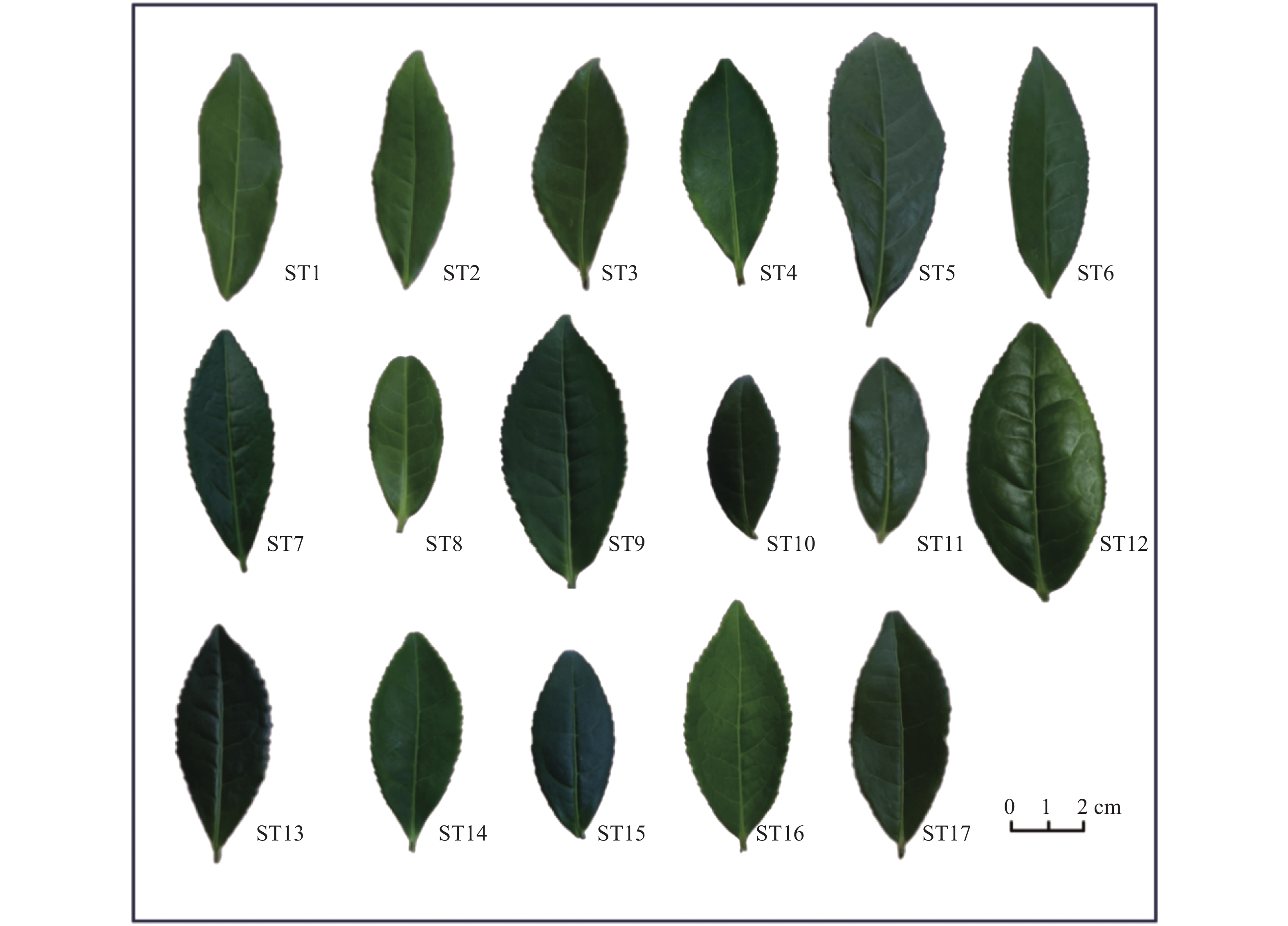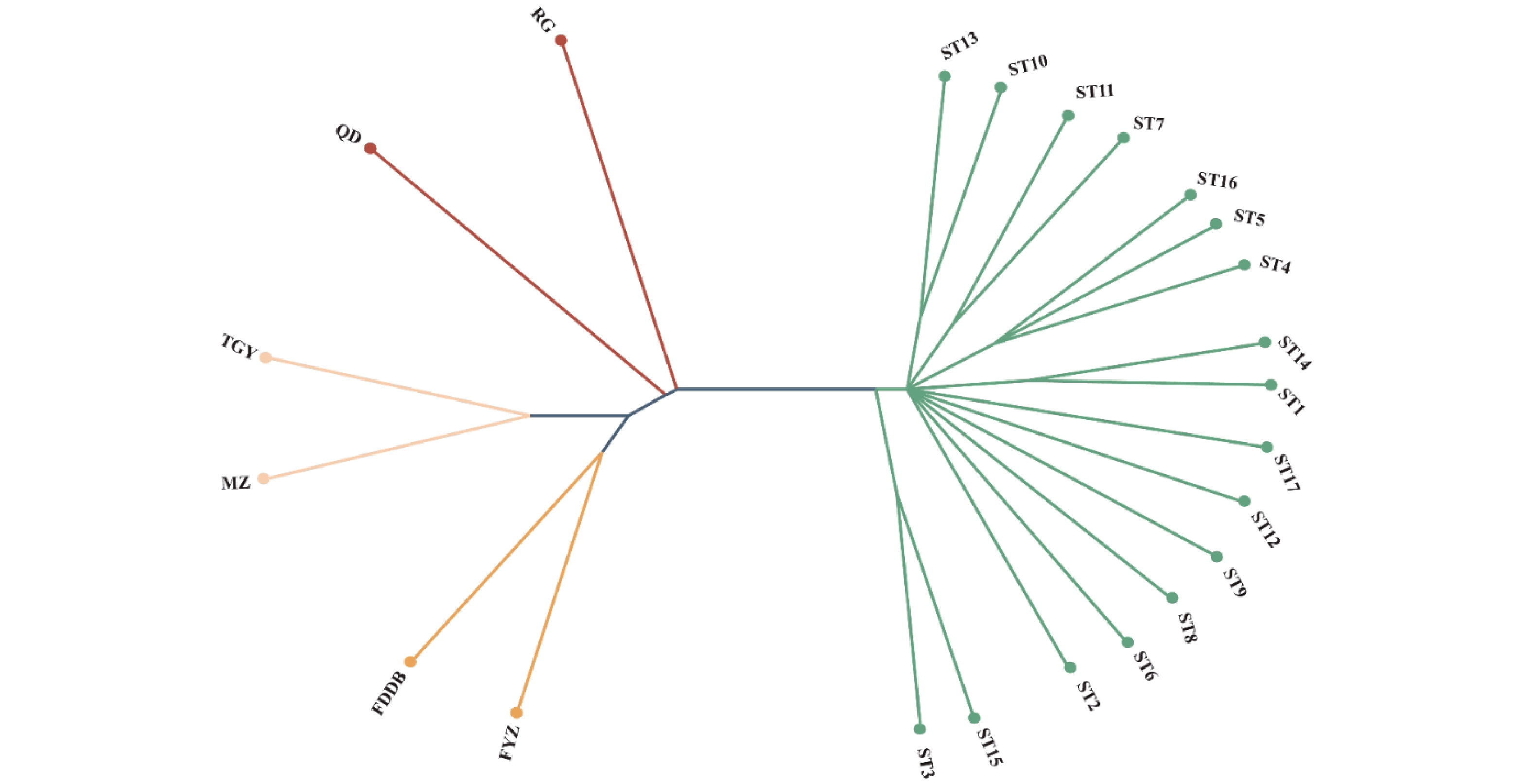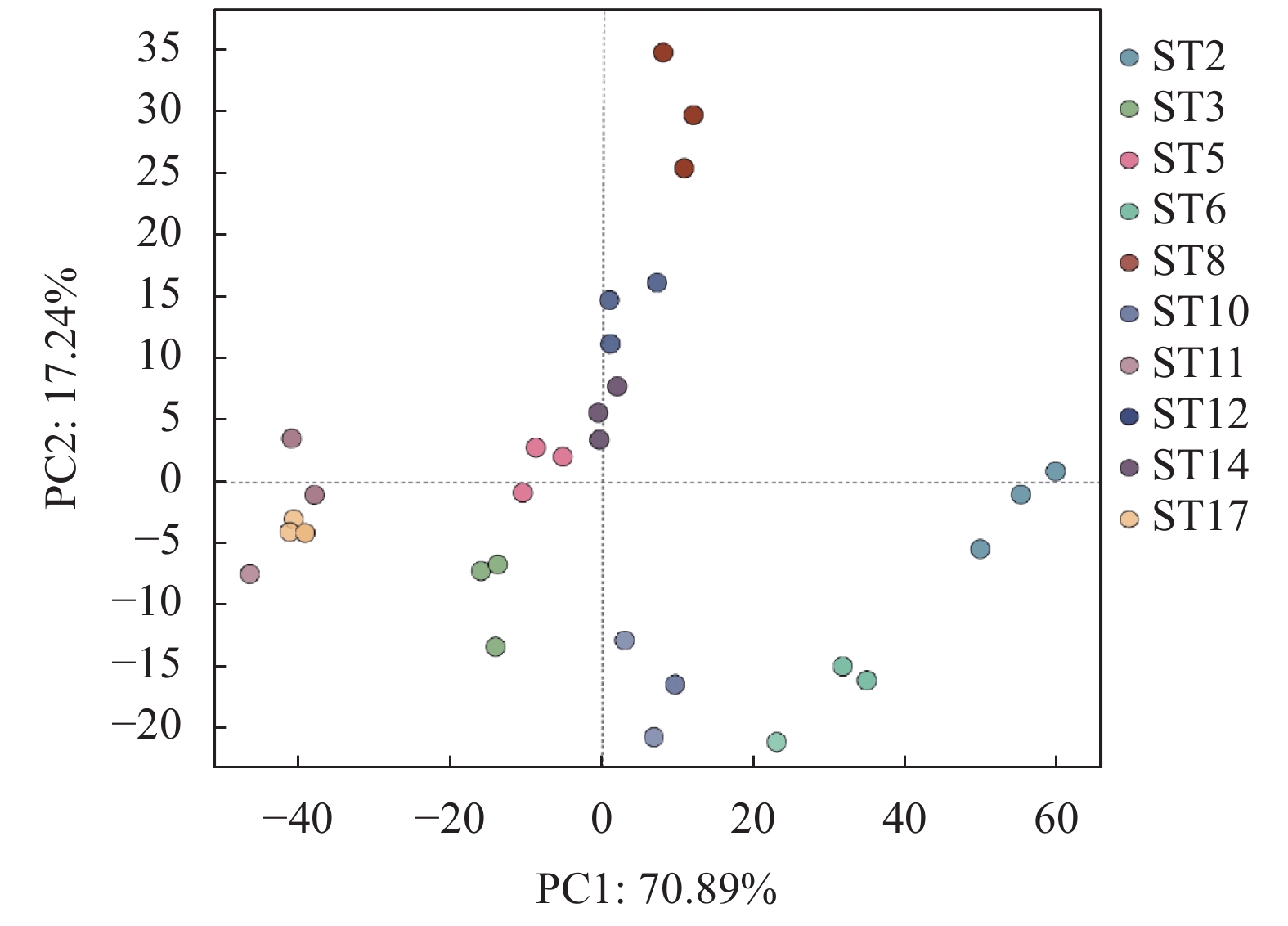Genetic Diversity and Principal Components of Tea Germplasms from Shiting Plantations in Nan'an
-
摘要:
目的 深入了解南安石亭群体种茶树种质资源(Camellia sinensis)的遗传多样性及其直接利用价值,为南安石亭群体种茶树种质资源的创新利用提供科学依据。 方法 利用SNP分子标记技术对17份南安石亭群体种茶树种质资源及福建6个代表性品种进行亲缘关系及遗传多样性分析。进一步采用高效液相色谱法(HPLC)和超高效液相色谱-串联质谱法(UPLC-MS/MS)测定代表性的10份南安石亭群体种茶树种质资源儿茶素及游离氨基酸等组分含量。 结果 筛选出44个适用于鉴定南安石亭群体种茶树种质资源的SNP位点,构建南安石亭群体种茶树种质资源SNP指纹图谱。通过UPGMA进化树构建,发现23个样品可分为4个亚群,南安石亭群体种茶树种质资源与闽北地区的肉桂、奇丹亲缘关系较近。此外,进行了氨基酸,儿茶素含量分析,发现南安石亭群体种茶树种质资源的主要品质成分含量差异显著(P<0.05)。儿茶素总量为107.56~177.60 mg·g−1,游离氨基酸总量为8.46~32.66 mg·g−1。其中ST2、ST3、ST6、ST17具有较高的EGCG或EGCG3"Me含量,ST3氨基酸含量最高及儿茶素苦涩味指数最低。 结论 南安石亭群体种茶树种质资源丰富,与闽北地区茶树资源亲缘关系较为亲密。ST2、ST3、ST6和ST17具有较高的EGCG或EGCG3"Me含量,ST3适制绿茶,可进一步开展选育工作。 Abstract:Objective Genetic diversity of the tea germplasms preserved at Shiting plantations in Nan’an was studied for promoting the utilization of the local specialty. Methods SNP molecular marker technology was applied to analyze the genetic diversity and relationships of 17 tea germplasms from the Shiting plantations and 6 representative varieties from Fujian. HPLC and UPLC-MS/MS were employed to determine the contents of catechins and free amino acids in 10 selected samples for a comparison among the tea varieties. Results Forty-four SNP loci suitable for identifying the tea plants were selected. An SNP fingerprint profile of the germplasms was constructed. The UPGMA evolutionary tree divided the 23 germplasms into 4 subgroups, which showed a close relation with Rougui and Qidan teas from northern Fujian. Significant differences were found on the contents of major amino acids and catechins among the varieties (P<0.05) with total free amino acids from 8.46 mg·g−1 to 32.66 mg·g−1 and catechins ranging from 107.56 mg·g−1 to 177.60 mg·g−1. The germplasms coded ST2, ST3, ST6, and ST17 had high contents of EGCG or EGCG3"Me, while ST3 the most on amino acids and the least on catechin bitterness index. Conclusion Shiting plantations in Nan’an had a rich collection of tea germplasms that were closely related to those in northern Fujian. Among them, ST2, ST3, ST6, and ST17 teas had high contents of either EGCG or EGCG3"Me. ST3, specifically, appeared to be suitable for making green tea as well as in breeding programs. -
Key words:
- Shiting, Nan’an /
- Camellia sinensis /
- germplasm /
- genetic diversity /
- component analysis /
- SNP
-
表 1 17份南安石亭群体种茶树种质资源
Table 1. Germplasm resources of 17 C.sinensis plants planted in Shiting population, Nan'an
编号
Code茶树种质
Germplasm resours长宽比
Aspect ratio叶面积
Leaf area/cm2叶形
Blade shape叶色
Leaf color1 ST1 2.87 10.63 长椭圆形 黄绿色 2 ST2 2.83 10.47 长椭圆形 黄绿色 3 ST3 2.54 10.25 长椭圆形 黄绿色 4 ST4 2.32 10.15 椭圆形 黄绿色 5 ST5 2.61 14.31 长椭圆形 黄绿色 6 ST6 3.10 9.56 披针形 黄绿色 7 ST7 2.82 9.55 长椭圆形 深绿色 8 ST8 2.20 6.16 椭圆形 黄绿色 9 ST9 2.25 16.13 椭圆形 深绿色 10 ST10 2.37 5.99 椭圆形 深绿色 11 ST11 2.35 6.58 椭圆形 黄绿色 12 ST12 2.18 17.61 椭圆形 黄绿色 13 ST13 2.44 10.68 椭圆形 深绿色 14 ST14 2.52 9.34 长椭圆形 黄绿色 15 ST15 2.26 8.37 椭圆形 深绿色 16 ST16 2.17 13.65 椭圆形 黄绿色 17 ST17 2.50 11.83 椭圆形 黄绿色 表 2 南安石亭群体种茶树种质资源儿茶素组分含量
Table 2. Catechins of Shiting plantation tea germplasms
(单位:mg·g−1) 儿茶素类
CatechinsST2 ST3 ST5 ST6 ST8 ST10 ST11 ST12 ST14 ST17 非酯
型儿
茶素
Non-ester
catechinsGC 0.35±0.02f 0.96±0.05a 0.42±0.01ef 0.48±0.02def 0.85±0.02ab 0.49±0.06def 0.76±0.03bc 0.61±0.12cde 0.88±0.02ab 0.65±0.30cd EGC 23.68±1.41f 28.91±2.25e 38.57±2.38c 24.79±2.07ef 56.41±3.73a 29.40±3.30d 38.44±3.66c 45.12±3.11b 44.39±1.16b 31.80±0.40d C 1.72±0.06 2.15±0.18a 1.93±0.09ab 1.98±0.25ab 1.95±0.30ab 1.36±0.31 c 1.78±0.27ab 0.83±0.09de 0.91±0.08d 0.51±0.01e EC 13.83±1.40cd 11.89±0.79e 15.06±0.36c 7.06±0.49f 18.72±0.55a 8.13±0.34f 13.29±0.88d 17.44±1.07b 10.96±0.47e 7.82±0.13f 总量 39.58±2.06de 43.91±3.34d 55.98±2.77c 34.31±2.88e 77.93±4.35a 39.38±3.83de 54.27±4.77c 64.00±4.44b 57.14±1.74c 40.78±0.38d 酯型儿
茶素
Ester
catechinsEGCG 92.51±6.53a 52.21±3.22d 57.99±1.27cd 98.30±6.29a 61.37±2.20c 76.02±4.76b 40.30±3.97e 57.12±5.35cd 63.94±2.28c 39.60±0.91e EGCG3" Me 12.97±0.88b 13.27±0.66b 1.66±0.11e — 7.11±0.18c — 6.02±0.52d 6.55±0.48cd 6.36±0.25cd 18.18±0.14a ECG 31.75±2.02a 14.82±0.58e 17.63±0.43c 19.92±0.96b 17.16±0.47cd 14.93±0.70e 11.18±0.85f 15.77±1.11de 11.64±0.38f 7.58±0.12g CG 0.66±0.03c 0.94±0.05b 0.65±0.03c 0.62±0.02c — 0.65±0.02c — — — 1.41±0.08a 总量 137.89±9.45a 81.24±4.49d 77.93±1.79d 118.84±7.25b 85.64±2.86cd 91.6±5.44c 57.50±5.35f 79.44±6.88d 81.94±2.89d 66.77±0.88e 总儿茶素
Total
catechins177.47±11.15a 125.15±7.81ef 133.91±4.28de 153.15±9.93bc 163.57±6.84ab 130.98±7.64de 111.77±10.00fg 143.44±11.29cd 139.08±4.56cde 107.55±1.02g 儿茶素
苦涩味指数
Catechins
bitterness and
astringency index9.54±1.07c 6.90±0.13d 6.74±0.07de 15.87±0.07a 6.57±0.16de 12.73±0.30b 6.02±0.16e 6.49±0.15de 10.18±0.15c 9.56±0.18c 儿茶素
品质指数
Catechin
quality index524.60±7.00a 232.12±5.47d 196.46±10.04e 477.71±17.2b 139.46±6.84gh 311.54±33.00c 133.99±3.89h 161.41±3.74fg 170.25±2.58f 148.39±4.63fgh 数值表示3个样品均值±标准差;同行不同小写字母表示差异显著(P < 0.05);“-”表示未检测出。表3 同。
Data are standard deviation ± mean of triplicated samples; those with different lowercase letters on same row indicate significant differences at P<0.05; "-" indicates not detected. Same for Table 3.表 3 南安石亭群体种茶树种质资源氨基酸的组分含量
Table 3. Amino acids of Shiting plantation tea germplasms
(单位:mg·g−1) 氨基酸组分
Amino acid
componentsST2 ST3 ST5 ST6 ST8 ST10 ST11 ST12 ST14 ST17 鲜味类
FlavorThea 3.27±0.14e 9.98±0.13a 5.54±0.17d 2.07±0.12g 1.61±0.28h 7.17±0.38b 6.50±0.36c 2.62±0.19f 2.37±0.06fg 2.10±0.00g Pro 0.29±0.01e 0.69±0.02a 0.31±0.01e 0.52±0.04bc 0.37±0.18de 0.36±0.02de 0.47±0.04cd 0.60±0.02ab 0.40±0.04de 0.38±0.03de Glu 2.27±0.15bc 2.53±0.29b 0.61±0.05f 1.13±0.04e 0.97±0.14ef 1.93±0.00cd 1.76±0.23d 3.90±0.65a 4.09±0.13a 0.14±0.02g GABA 0.06±0.00a 0.06±0.00a 0.06±0.00a 0.06±0.00a 0.06±0.00a 0.06±0.00a 0.07±0.00a 0.07±0.00a 0.07±0.00a 0.07±0.00a Asp 0.30±0.14cd 0.59±0.01b 0.24±0.03de 0.88±0.04a 0.15±0.02ef 0.31±0.08cd 0.17±0.04ef 0.34±0.05cd 0.39±0.07c 0.12±0.01f 总量 6.20±0.26f 13.85±0.24a 6.76±0.19e 4.66±0.13g 3.16±0.35g 9.83±0.29b 8.96±0.2c 7.54±0.49d 7.31±0.09d 0.81±0.01h 甜味类
SweetnessAla 0.13±0.04f 0.28±0.01de 0.14±0.03f 0.18±0.04ef 0.46±0.1c 0.47±0.06c 0.93±0.09b 0.39±0.02cd 0.16±0.04ef 2.00±0.17a Thr 0.22±0.03e 0.53±0.03a 0.27±0.02d 0.41±0.03b 0.17±0.04e 0.35±0.02c 0.36±0.03c 0.36±0.02c 0.35±0.04c 0.21±0.02e Asn 0.28±0.03cd 0.57±0.2a 0.24±0.07cd 0.6±0.01a 0.19±0.04d 0.37±0.12bc 0.29±0.04cd 0.35±0.02bcd 0.48±0.06ab 0.24±0.02cd Ser 0.37±0.01f 1.24±0.06a 0.47±0.05ef 0.8±0.08c 0.55±0.03def 1.00±0.08b 0.66±0.31cde 0.8±0.02c 0.75±0.05cd 0.43±0.07f Gly 0.04±0.01d 0.06±0.02cd 0.25±0.03a 0.09±0.02cd 0.12±0.07c 0.06±0.04cd 0.19±0.01b 0.05±0.03d 0.06±0.05cd 0.1±0.04cd Gln 3.15±0.27b 3.10±0.02b 0.47±0.10f 1.59±0.08e 1.00±0.17e 3.76±0.18a 2.58±0.34c 2.99±0.27b 3.69±0.13a 0.18±0.03f 总量 4.22±0.13d 5.80±0.05ab 1.85±0.03g 3.96±0.22d 2.45±0.28f 5.94±0.37a 4.88±0.17c 4.93±0.3c 5.40±0.35b 3.03±0.19e 芳香类
AromaticLys 0.21±0.04cd 0.62±0.03a 0.15±0.02de 0.42±0.03b 0.19±0.08cd 0.24±0.02c 0.25±0.01c 0.38±0.02b 0.23±0.03c 0.11±0.04e Tyr 0.53±0.05cd 0.61±0.03c 0.49±0.04de 0.81±0.07b 0.54±0.1cd 0.41±0.04ef 0.85±0.07b 2.24±0.03a 0.55±0.01cd 0.36±0.08g Trp 0.47±0.04a 0.27±0.02c 0.16±0.04e 0.33±0.03b 0.17±0.04e 0.16±0.00e 0.17±0.01e 0.28±0.02c 0.22±0.01d 0.08±0.02f 总量 1.21±0.13c 1.5±0.02b 0.79±0.03e 1.56±0.04b 0.90±0.16de 0.81±0.06e 1.27±0.08c 2.9±0.05a 1.00±0.02d 0.55±0.11f 苦味类
BittersArg 2.81±0.15d 8.25±0.46a 4.93±0.13c 1.86±0.12e 0.98±0.36f 5.91±0.27b 6.30±0.31b 2.18±0.3e 2.11±0.25e 0.14±0.01g Leu 0.28±0.01ef 1.07±0.02a 0.45±0.06bc 0.5±0.04b 0.33±0.04de 0.27±0.02ef 0.24±0.03fg 0.39±0.06cd 0.34±0.02de 0.2±0.04g Ile 0.31±0.02cd 0.91±0.21a 0.45±0.09bc 0.48±0.03b 0.06±0.03f 0.22±0.00def 0.22±0.05def 0.29±0.11cde 0.38±0.09bcd 0.14±0.03ef His 0.11±0.02cd 0.15±0.02b 0.09±0.01d 0.19±0.00a 0.11±0.04cd 0.11±0.02cd 0.12±0.02bcd 0.14±0.01bc 0.11±0.02bcd 0.09±0.02d Val 0.18±0.03e 0.49±0.02a 0.12±0.01f 0.40±0.01b 0.06±0.03g 0.22±0.03d 0.21±0.02de 0.33±0.02c 0.23±0.01d 0.06±0.02g 总量 3.68±0.18d 10.86±0.36a 6.04±0.29c 3.43±0.15de 1.54±0.38f 6.73±0.22b 7.09±0.29b 3.33±0.27de 3.17±0.31e 0.62±0.08g 其他
Otherβ-ABA 0.09±0.01e 0.11±0.01e 2.42±0.27b 0.08±0.01e 0.85±0.26d 0.16±0.04e 2.67±0.22a 1.24±0.13c 0.07±0.01e 0.90±0.04d sar 0.17±0.01c 0.22±0.04bc 0.23±0.00bc 0.31±0.13abc 0.19±0.03bc 0.34±0.14ab 0.33±0.09abc 0.28±0.06abc 0.41±0.06a 0.32±0.10abc 总氨基酸 15.55±0.39f 32.32±0.44a 18.09±0.7e 13.70±0.08g 9.15±0.68h 24.87±0.57c 25.32±0.19b 20.21±0.52d 17.47±0.8e 8.35±0.27i -
[1] 阚能才. 茶树起源与川渝野生茶树分布研究 [J]. 西南农业学报, 2013, 26(1):382−385. doi: 10.3969/j.issn.1001-4829.2013.01.080KAN N C. Study on geographical distribution of wild tea trees in Sichuan and Chongqing, and origin of tea tree [J]. Southwest China Journal of Agricultural Sciences, 2013, 26(1): 382−385. (in Chinese) doi: 10.3969/j.issn.1001-4829.2013.01.080 [2] 黄天柱, 廖渊泉. 石亭茶香飘海宇 [J]. 农业考古, 1991(4):227.HUANG T Z, LIAO Y Q. Shi Ting Cha Xiang Piao Hai Yu [J]. Agricultural Archaeology, 1991(4): 227. (in Chinese) [3] 林金良, 陈育才. 九日山和石亭绿茶文化资源探讨[J]. 福建茶叶, 2020, 42(11): 307-309.LIN J L, CHEN Y C. Discussion on jiuri mountain heshiting green tea cultural resources[J]. Tea in Fujian, 2020, 42(11): 307-309. (in Chinese) [4] WANG B Y, TAN H W, FANG W P, et al. Developing single nucleotide polymorphism (SNP) markers from transcriptome sequences for identification of Longan (Dimocarpus longan) germplasm [J]. Horticulture Research, 2015, 2: 14065. doi: 10.1038/hortres.2014.65 [5] XU C, REN Y H, JIAN Y Q, et al. Development of a maize 55 K SNP array with improved genome coverage for molecular breeding [J]. Molecular Breeding, 2017, 37(3): 20. doi: 10.1007/s11032-017-0622-z [6] 郭灿, 皮发娟, 吴昌敏, 等. 基于GBS测序的全基因组SNP揭示贵州地方茶组植物资源的亲缘关系 [J]. 南方农业学报, 2021, 52(3):660−670. doi: 10.3969/j.issn.2095-1191.2021.03.014GUO C, PI F J, WU C M, et al. Genome-wide SNP developed by genotyping-by-sequencing revealed the phylogenetic relationship of Sect. Thea(L. ) Dyer resources in Guizhou [J]. Journal of Southern Agriculture, 2021, 52(3): 660−670. (in Chinese) doi: 10.3969/j.issn.2095-1191.2021.03.014 [7] LIN Y, YU W T, CAI C P, et al. Rapid varietal authentication of oolong tea products by microfluidic-based SNP genotyping [J]. Food Research International, 2022, 162: 111970. doi: 10.1016/j.foodres.2022.111970 [8] LIU C G, YU W T, CAI C P, et al. Genetic diversity of tea plant (Camellia sinensis (L. ) kuntze) germplasm resources in Wuyi mountain of China based on single nucleotide polymorphism (SNP) markers [J]. Horticulturae, 2022, 8(10): 932. doi: 10.3390/horticulturae8100932 [9] CHEN Y J, NIU S Z, DENG X Y, et al. Genome-wide association study of leaf-related traits in tea plant in Guizhou based on genotyping-by-sequencing [J]. BMC Plant Biology, 2023, 23(1): 196. doi: 10.1186/s12870-023-04192-0 [10] LIAO Y Y, ZHOU X C, ZENG L T. How does tea (Camellia sinensis) produce specialized metabolites which determine its unique quality and function: A review [J]. Critical Reviews in Food Science and Nutrition, 2022, 62(14): 3751−3767. doi: 10.1080/10408398.2020.1868970 [11] WILLIAMS J L, EVERETT J M, D’CUNHA N M, et al. The effects of green tea amino acid L-theanine consumption on the ability to manage stress and anxiety levels: A systematic review [J]. Plant Foods for Human Nutrition, 2020, 75(1): 12−23. doi: 10.1007/s11130-019-00771-5 [12] 江新凤, 李琛, 石旭平, 等. 高效液相色谱法对“黄金菊” 茶中儿茶素和氨基酸组分含量的测定 [J]. 食品研究与开发, 2021, 42(5):172−176. doi: 10.12161/j.issn.1005-6521.2021.05.029JIANG X F, LI C, SHI X P, et al. HPLC determination of catechin and amino acid components in Camellia sinensis ‘huangjinju’ [J]. Food Research and Development, 2021, 42(5): 172−176. (in Chinese) doi: 10.12161/j.issn.1005-6521.2021.05.029 [13] UNNO K, NAKAMURA Y. Green tea suppresses brain aging [J]. Molecules, 2021, 26(16): 4897. doi: 10.3390/molecules26164897 [14] JIN J Q, JIANG C K, YAO M Z, et al. Baiyacha, a wild tea plant naturally occurring high contents of theacrine and 3″-methyl-epigallocatechin gallate from Fujian, China [J]. Scientific Reports, 2020, 10(1): 9715. doi: 10.1038/s41598-020-66808-x [15] 金基强, 张晨禹, 马建强, 等. 茶树种质资源研究“十三五” 进展及“十四五” 发展方向 [J]. 中国茶叶, 2021, 43(9):42−49,76. doi: 10.3969/j.issn.1000-3150.2021.09.006JIN J Q, ZHANG C Y, MA J Q, et al. Research progress on tea germplasms during the 13th Five-Year Plan period and development direction in the 14th Five-Year Plan period [J]. China Tea, 2021, 43(9): 42−49,76. (in Chinese) doi: 10.3969/j.issn.1000-3150.2021.09.006 [16] WANG P J, GU M Y, SHAO S X, et al. Changes in non-volatile and volatile metabolites associated with heterosis in tea plants (Camellia sinensis) [J]. Journal of Agricultural and Food Chemistry, 2022, 70(9): 3067−3078. doi: 10.1021/acs.jafc.1c08248 [17] 江昌俊. 茶树育种学[M]. 北京: 中国农业出版社: 2005. [18] FANG W P, MEINHARDT L W, TAN H W, et al. Varietal identification of tea (Camellia sinensis) using nanofluidic array of single nucleotide polymorphism (SNP) markers [J]. Horticulture Research, 2014, 1: 14035. doi: 10.1038/hortres.2014.35 [19] 樊晓静, 于文涛, 蔡春平, 等. 利用SNP标记构建茶树品种资源分子身份证 [J]. 中国农业科学, 2021, 54(8):1751−1772. doi: 10.3864/j.issn.0578-1752.2021.08.014FAN X J, YU W T, CAI C P, et al. Construction of molecular ID for tea cultivars by using of single-nucleotide polymorphism(SNP) markers [J]. Scientia Agricultura Sinica, 2021, 54(8): 1751−1772. (in Chinese) doi: 10.3864/j.issn.0578-1752.2021.08.014 [20] 徐梦婷, 魏明秀, 陈潇敏, 等. 寿宁长叶1号等茶树新品系儿茶素和氨基酸组分分析 [J]. 茶叶学报, 2022, 63(1):20−26. doi: 10.3969/j.issn.1007-4872.2022.01.004XU M T, WEI M X, CHEN X M, et al. Catechins and amino acids in shouningchangye No. 1 and other new tea varieties [J]. Acta Tea Sinica, 2022, 63(1): 20−26. (in Chinese) doi: 10.3969/j.issn.1007-4872.2022.01.004 [21] ZHANG Y N, YIN J F, CHEN J X, et al. Improving the sweet aftertaste of green tea infusion with tannase [J]. Food Chemistry, 2016, 192: 470−476. doi: 10.1016/j.foodchem.2015.07.046 [22] 李芬, 陈春林, 田玉萍, 等. 云南不同品种大叶种茶树生化成分季节变化特征分析 [J]. 食品与生物技术学报, 2022, 41(3):88−95. doi: 10.3969/j.issn.1673-1689.2022.03.012LI F, CHEN C L, TIAN Y P, et al. Seasonal Variation of Biochemical Components of Different Cultivars of Camellia sinensis var. assamica in Yunnan [J]. Journal of Food Science and Biotechnology, 2022, 41(3): 88−95. (in Chinese) doi: 10.3969/j.issn.1673-1689.2022.03.012 [23] YU P H, HUANG H, ZHAO X, et al. Dynamic variation of amino acid content during black tea processing: A review [J]. Food Reviews International, 2023, 39(7): 3970−3983. doi: 10.1080/87559129.2021.2015374 [24] HUANG X J, CAO H L, GUO Y L, et al. The dynamic change of oolong tea constitutes during enzymatic-catalysed process of manufacturing [J]. International Journal of Food Science & Technology, 2020, 55(12): 3604−3612. [25] LIU Z Y, RAN Q S, LI Q, et al. Interaction between major catechins and umami amino acids in green tea based on electronic tongue technology [J]. Journal of Food Science, 2023, 88(6): 2339−2352. doi: 10.1111/1750-3841.16543 [26] JIN J Q, MA J Q, MA C L, et al. Determination of catechin content in representative Chinese tea germplasms [J]. Journal of Agricultural and Food Chemistry, 2014, 62(39): 9436−9441. doi: 10.1021/jf5024559 [27] 杨春, 吴昌敏, 石伟昌, 等. 黎平地方茶树资源生化成分多样性分析及优异单株鉴选 [J]. 种子, 2020, 39(10):63−66,72.YANG C, WU C M, SHI W C, et al. Diversity analysis of biochemical components of local tea tree resources in Liping Region and excellent individual plant selection [J]. Seed, 2020, 39(10): 63−66,72. (in Chinese) [28] ZHANG M, ZHANG X, HO C T, et al. Chemistry and health effect of tea polyphenol (–)-epigallocatechin 3-O-(3-O-methyl)gallate [J]. Journal of Agricultural and Food Chemistry, 2019, 67(19): 5374−5378. doi: 10.1021/acs.jafc.8b04837 [29] LI J H, CHEN S X, ZHU M Z, et al. Cluster analysis of the biochemical composition in 53 Sichuan EGCG3"Me tea resources [J]. IOP Conference Series: Materials Science and Engineering, 2017, 231: 012125. doi: 10.1088/1757-899X/231/1/012125 [30] XU C H, LIANG L, LI Y H, et al. Studies of quality development and major chemical composition of green tea processed from tea with different shoot maturity [J]. LWT, 2021, 142: 111055. doi: 10.1016/j.lwt.2021.111055 [31] JIANG H, YU F, QIN L, et al. Dynamic change in amino acids, catechins, alkaloids, and Gallic acid in six types of tea processed from the same batch of fresh tea (Camellia sinensis L. ) leaves [J]. Journal of Food Composition and Analysis, 2019, 77: 28−38. doi: 10.1016/j.jfca.2019.01.005 [32] ZHANG L, CAO Q Q, GRANATO D, et al. Association between chemistry and taste of tea: A review [J]. Trends in Food Science & Technology, 2020, 101: 139−149. [33] LI Y C, RAN W, HE C, et al. Effects of different tea tree varieties on the color, aroma, and taste of Chinese Enshi green tea [J]. Food Chemistry: X, 2022, 14: 100289. doi: 10.1016/j.fochx.2022.100289 [34] HU S, HE C, LI Y C, et al. Changes of fungal community and non-volatile metabolites during pile-fermentation of dark green tea [J]. Food Research International, 2021, 147: 110472. doi: 10.1016/j.foodres.2021.110472 -








 下载:
下载:




